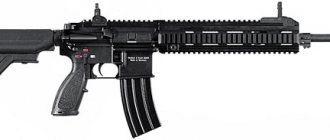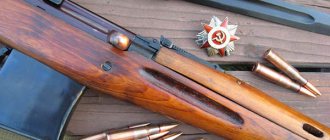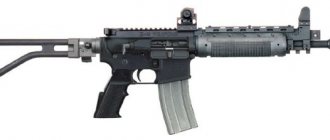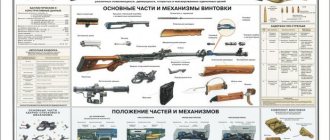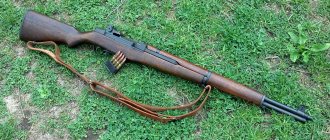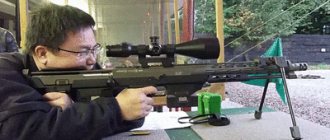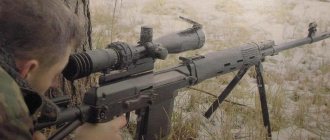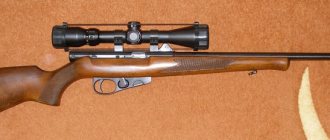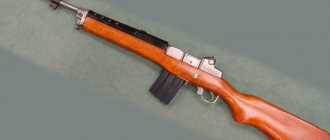Walther G41/Gewehr 41 sniper rifle
The need to increase the firepower of the Wehrmacht infantry during the Second World War required the creation of individual automatic weapons, primarily self-loading rifles.
The result of significant development work was the development in 1941 by Mauser-Werke and Carl Walther of two rifle models with fairly similar characteristics.
To objectively evaluate the new weapon, in September-October 1941, the Mauser G41 (M) and Walter G41 (W) self-loading rifles were sent for extensive military testing directly on the Eastern Front.
| G41(M) |
The test results showed that the G41 (M) rifle is very complex in its design, and constant delays in the operation of the automation due to contamination or heating of the barrel make it unsuitable for use in the army. As a result, they decided to abandon the Mauser system.
The G41 (W) rifle showed more reliable operation in difficult field conditions and acceptable service and operational qualities. Despite its major shortcomings - large mass, strong recoil, slow reloading - the Wehrmacht command, taking into account the significant needs of the front for automatic weapons, adopted this system for service under the symbol G41 in December 1942 (before the start of its deliveries, Wehrmacht units widely used captured Soviet SVT-40 rifles, which received the German designation 453 (r)).
| G41(W) |
In addition to regular use by infantry, the new G41 rifle was also used as a sniper weapon.
The only difference between the G41 sniper model and the standard G41 rifle was the presence of an optical sight mounted on top of the receiver.
Individual trained snipers were armed with the G41 sniper rifle.
The automatic operation of the Walter self-loading rifle (as well as the Mauser rifle) is based on the use of the energy of part of the powder gases removed from the barrel bore by means of a stationary muzzle, which, along with the cylinder, pusher and piston, is part of the gas outlet device. Powder gases pass through the oval channels of the muzzle into the cylinder and act on the piston. The piston pushes back the pusher, which in turn pushes back the bolt stem (and at the same time compresses the return spring, under the action of which the pusher and piston move back).
| Caliber, mm | 7.92×57 |
| Length, mm | 1138 |
| Barrel length, mm | 546 |
| Weight without cartridges, kg | 4.9 |
| Effective firing range, m | 600 — 800 |
| Initial bullet speed, m/s | 745 |
| Rate of fire, rds/min | 20 — 30 |
| Magazine capacity, no. cartridges | 10 |
The bolt is locked by two lugs located symmetrically in the bolt. The lugs move apart and close when locking and unlocking with a wedge, which is also located in the bolt and is driven by the bolt stem.
The rifle has a hammer-type impact mechanism; its trigger mechanism allows firing only single shots.
To prevent accidental shots, the rifle has a safety lever mounted on the rear of the receiver. The safety is turned on by turning the flag to the right, which locks the trigger.
The G41 self-loading rifle uses the same ammunition as the 1898 model repeating rifle.
| G41 standard sniper rifle |
The rifle is fed with ammunition from an integral magazine with a capacity of 10 rounds, filled using clips. After all the cartridges in the magazine are used up, the bolt remains in the rear position, which signals the need to fill the magazine.
The rifle is standardly equipped with a simple sector sight.
With the widespread use of G41 self-loading rifles in the front-line units of the Wehrmacht in 1942-43. Very significant shortcomings of this weapon were revealed: too much weight, frequent delays in firing caused by even slight contamination of the sliding parts, low shooting accuracy and the inconvenience of filling the integral magazine with cartridges.
G41 was produced in a small series. In total, about 70,000 rifles were ordered. Production of this rifle was discontinued in the spring of 1943.
In 1943, the rifle was modernized and received the G43 index.
| G41 |
G-41(W) - German self-loading Walter rifle
By its appearance, Gewehr 41 is a German self-loading Walter
G-41 (W) rifle, which was successfully used during the Second World War and the Great Patriotic War on all fronts for which the rifle was fired using ordinary German rifle cartridges of 7.92×57 mm caliber. its appearance is due to the fact that in 1940, the Main Directorate of Armaments and Ammunition of the German Ground Forces - Hitler put forward additional requirements for a modern self-loading rifle for the Wehrmacht troops.
The beginning of the creation of a self-loading rifle for the German army is often justified by the large number of multi-shot self-loading rifles available in the Red Army units: (ABC-36, SVT-38/40). During the first stage of the 1941 offensive and Operation Barbarossa in 1941, the Germans received in huge quantities as a trophy the Tokarev self-loading rifle and a huge number of cartridges for it, which became the first truly self-loading rifle adopted by the German troops. Nazi industry studied captured weapons,
developed a series of its own self-loading combat rifles, introducing into the design a system for removing powder gases, used in the Russian Tokarev rifle. As planned, in the winter of 1941, new self-loading rifles of several similar types began to arrive in large numbers to the Wehrmacht combat units for front-line testing: developed by the well-known companies Walther G-41 (W) and Mauser G-41 (M. B current tests in self-loading systems major shortcomings were discovered. In a report to Hitler about the experience of using a self-loading German rifle of the Walther system, there was a note: “In fact, the rifle poorly justified itself... Almost the 3rd and 4th shots created a delay for various reasons, such as not ejecting cartridges, not closing the bolt, which may occur and as a result of even slight contamination of the sliding parts of the device. Cleaning must be done very carefully, since as a result of powder carbon deposits and high temperature, the sliding parts stick together, which makes disassembling the rifle and its maintenance much more difficult. The rifle is too heavy to carry, it moves and moves when touched. loses aim.The rifle makes it difficult for infantry units to march, burdening the fighters with its large weight. The Wehrmacht shooter, after briefly using the rifle in several battles, handed it over, demanding that the 98k carbine be returned to him, since the self-loading rifle created more problems for him than it was worth.”
A corresponding review was also found about the new Mauser rifle: “In practice, the rifle is very heavy and inconvenient. The sliding parts of the weapon must be constantly lubricated.
The muzzle flash suppressor is especially demanding and capricious, since after 30 shots it burns firmly. It is very sensitive to fine dirt and dust, which constantly causes delays in firing and causes the weapon’s feed mechanism to become inoperative. The statistics are as follows: for 10 shots there were 9 delays. Although in the future the designers managed to remove many of the noted shortcomings, some problems were never resolved.
Based on the results of tests at the front, this formidable weapon in the period 1942-1943 under the symbol G-41 (W) was adopted for arming troops with a Walter rifle system. The rifle did not gain much merit and was produced in small numbers, since its design had many serious shortcomings, including low reliability, sensitivity to minor contamination, and large mass. The rifle was made by Walther at a weapons factory in the small town of Zella-Mehlis and by Berlin-Lübecker Maschine in Lübeck. But German designers confirmed their fame as great gunsmiths and in 1943, modernized G-43(W) rifles began to appear in Wehrmacht units, which fought until the end of World War II.
The G43(W) differs from the original G41(W) in the following ways: 1. The weight has been reduced by approximately 600 grams and the overall length of the rifle has become shorter by 23 mm. 2. The muzzle was removed, which was replaced in the middle part of the barrel by a simple gas chamber without a regulator. 3. A detachable magazine was installed instead of a non-removable one. 4. The rifle's charging handle has been moved to the left. 5. Added a boss for attaching the optical sight bracket.
Gewehr 41 and Gewehr 43
Gewehr 41 and Gewehr 43 are self-loading rifles developed by Carl Walther for the standard German rifle cartridge 7.92x57 mm.
History of creation and production
Before the outbreak of World War II, the German Armed Forces showed no interest in self-loading rifles. Infantry tactics were built around single machine guns, supported by infantrymen with Kar.98k repeating rifles. Only the study of the capabilities of the future enemy pushed the Wehrmacht towards self-loading weapons. The fact is that by that time the Red Army had such types of self-loading and automatic rifles as ABC-36, SVT-38 and SVT-40.
As a result, in 1940, the Armaments Department of the German Army (HWaA) put forward requirements for a new self-loading rifle for the Wehrmacht, and among such requirements were, among other things, the absence of external parts of the weapon moving when fired, the possibility of firing with manual reloading (in case of automatic failures) and the absence of gas outlets in the barrel.
Due to the latter requirement, the designers had to use a scheme with gas removal from the muzzle of the barrel through the muzzle, while the gas piston had the form of a ring located around the muzzle of the barrel. Such a system required a long kinematic connection between the gas piston and the bolt group, which dramatically complicated the weapon and worsened its balance.
Background [edit]
By 1940, it became apparent that some form of semi-automatic rifle with a higher rate of fire than existing bolt-action rifle models was needed to improve infantry combat effectiveness. The Army released specifications to various manufacturers, and Mauser and Walther presented prototypes that were very similar. However, there were some restrictions on the design:
- there should be no holes in the barrel for gas removal for the loading mechanism;
- rifles should not have moving parts on the surface;
- and in the event of failure of the self-loading mechanism, it was necessary to turn on the shutter.
Therefore, both models used a mechanism known as the Bang system (after the Danish designer Søren H. Bang). In this system, powder gases were captured by a conical gas trap at the muzzle, which in turn deflected them, driving a small piston, which in turn pressed on a long piston rod, which opened the breech and reloaded the gun. This is in contrast to the more common type of gas system, in which gases are diverted from the barrel and push the piston, opening the bolt rearward. Both also included fixed 10-round magazines, which were loaded using two Karabiner 98k stripper clips, using the same German standard 7.92×57mm Mauser rounds. This in turn made reloading relatively slow (compared to rifles that had magazines that could be reloaded from a single unit, such as the M1 Garand, although this was typical of its time, being identical to the reloading procedure of a 10-shot Lee –Enfield).
Mauser's model, the G41(M), was the only one of the two that met the established criteria. The result was a rifle that was overly complex, unreliable, clunky, and heavy. It included the familiar aiming and control system with the standard Kar98k rifle. The G41(M) had a striker-fired, rotary-bolt locking and a traditional bolt handle/charging handle that automatically disconnected the bolt assembly from the recoil spring if the rifle was used in manual mode. The cam fuse box also blocks the firing pin. Only 6,673 examples were produced before production was stopped, of which 1,673 were returned unusable. Accuracy problems were noted as the front sight was mounted on the gas tube in front of the barrel, creating play after sustained fire. Most of the metal parts on this rifle were machined steel, and some rifles, especially later examples, used Bakelite-type plastic hand guards.
The Walther design was more successful because the designers simply ignored the last two limitations listed above. With no bolt, the receiver area was much cleaner than the M version. However, the Walther and Mauser versions suffered from problems with gas system clogging as the gases at the muzzle cooled and deposited particulate carbon. These problems also appeared to be due to excessive muzzle trap corrosion due to the use of corrosive salts in the ammunition primers. The muzzle consisted of many tightly fitting parts and was difficult to keep clean, disassemble and maintain in the field.
G41(W) rifles were produced in two factories: Walther in Zella Mehlis and Berlin-Lübecker Maschinenfabrik. Walther pistols are coded AC with inspection evidence WaA359, and BLM pistols are coded DUV with inspection evidence WaA214. These rifles are also relatively rare and are highly collectible. According to various sources, production volume ranges from 40,000 to 145,000 units. Again, these rifles showed high levels of attrition on the Eastern Front.
The Walther rifle was redesigned in 1943 as the Gewehr 43, using a short-stroke piston copied from the SVT-40 rifle and a conventional detachable box magazine.
